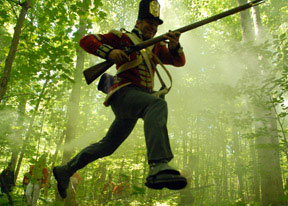
How many of you have groaned your way through cringe-worthy reenactments in history documentaries? Let me see a show of hands in early 19th century gauntlets. Do you have any idea how much it costs to rent those gauntlets. If you throw them down please remember to have them dry-cleaned before returning them to the costume department.
Recently I’ve been dragged into the treacherous world of history documentary reenactments, not from a desire to ruin my reputation, but by hard and cruel necessity. The need is simply this – sometimes there is just nothing else to show. The low-hanging fruit of history films is any subject since photography became popular; the even easier gleanings are any subjects since motion pictures left the nickelodeons. PBS and the History Channel have dug deep in the mine of film and photo archives. Every war since the Civil one has been treated ad nauseum, as well as all our post 1860s presidents, entertainers, and political crises. Most history film proposals include the line, “we have discovered a treasure trove of motion picture and still images.” No producer wants to hear the funder say, “but what are you going to show?”
That’s the question we asked ourselves when we began work on the last PBS war – The War of 1812 (a co-production WNED, Buffalo/Toronto and Florentine Films/Hott Productions coming to your television in fall 2011). It’s the only war PBS hasn’t done and for a good reason. It’s almost forgotten here in the USA and those who remember it are a little unclear about its details. Here’s a very quick primer. James Madison and his friends were upset: the British were impressing American seamen, interfering with American trade, and stirring up Indian warfare in the Northwest. Britain was far away so we decided to attack the nearest British territory – Canada. Thomas Jefferson thought that taking Canada would be a mere matter of marching but boy, was he wrong. You’ll have to watch the film to see how things turned out, but here’s a hint (spoiler alert!): the USA is still a sovereign nation.
The War of 1812 hasn’t been covered much on American television for another reason. It all happened before the age of photography. There are lots of charming woodcuts, bombastic paintings, and stirring broadsides about the war, but that’s hardly enough visual material to get across the Battle of Lundy’s Lane, for instance, where British and American soldiers fought in a graveyard next to Niagara Falls throughout an entire night, stopping at dawn to search for survivors among the hundreds of dead strewn among the tombstones. It was a confusing, brutal war. No matter how many times you pan slowly across a painting, the fog of war will dissipate before the viewer has a visceral reaction.
Enter Hollywood, or at least the Hollywood approach. The solution to not having film and photo archives is create your own – the reenactment. The problem is that the documentarian is competing against the expectations of the viewer for realistic, high-quality, well-acted images. Hollywood has set the bar rather high. A documentary filmmaker’s entire production budget is often less than the catering costs for one week on a Hollywood set.
The challenges shooting reenactments for The War of 1812 were many. How do we create the feeling of thousands of soldiers when we can only pay for twenty men at a time? How do we film battle scenes when we can’t afford to show bullets ripping through bodies and heads exploding? What about battle ships, cannon shots, entire cities on fire?
The answer is to let the tiny stand in for the grand. There are standard deceptions, such as filming boots marching in circles around the camera, but that gets old fast. We opted for concentrating on the details of platoons, cameos of James and Dolley Madison and the Generals on both sides, and the stories of individual soldiers told through their diaries. We rented period battle ships, and hired a reenactment coordinator, a special effects expert, a hair and makeup whiz. We resorted to a convenient trick, filming at nightfall, using copious plumes of fake smoke to hide the fact that our battalions of soldiers were a mere twenty reenactors.
The reenactors saved the day. For the most part, these men have been reliving battles from the War of 1812 for years. They come to the film set with their own costumes. Some even have three sets of clothing: British uniforms, American uniforms, and militia outfits. I asked one group of men why they would want to play at killing and dying. They said they were Viet Nam vets, they had been wounded in a real war and yet they still wanted to load black powder muskets, wear scratchy wool uniforms, and sleep on the ground. What they got out of it, they said, was a deeper understanding of history than a book, or even documentary, could provide.
I thought about those real combat vets turned ersatz soldiers when making plans for one of our major reenactment shoots. Our goal is to give the audience a sense of verisimilitude. Perhaps there is some truth in photographic and film archives, but those images are not always trustworthy. Photos can be cropped, films can be staged. When we film them we chose what details to emphasize, what scenes to feature. We do the same thing with reenactments of course, but the audience knows that what they are seeing is not supposed to be archival. They are a representation of what the filmmaker thinks the world of the past looked like. Perhaps, in some ways, the reenactment is more honest than the hoary photos and films that we believe are true representations of history.
Photo: Courtesty of Florentine Films/Hott Productions


